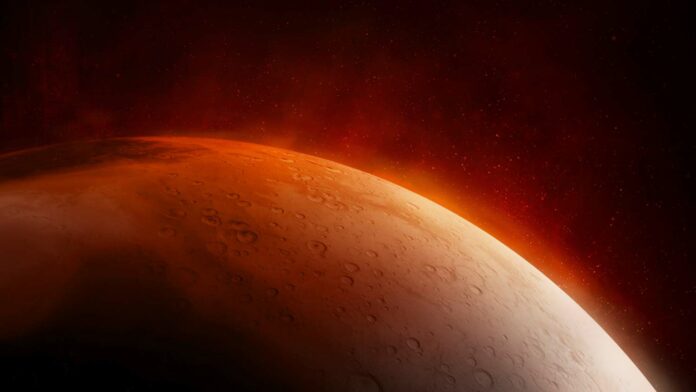Mars, just like all the other planets in our solar system, is always surrounded by something called the solar wind. This wind pushes on the magnetic field and the outer layer of gases around Mars. Sometimes, the solar wind can cause exciting events.
In December 2022, there was a special event where faster solar wind caught up with slower solar wind. It was like a faster wind sweeping and pressing the two winds together. This created something called a “stream interaction region.” After this happened, there was an empty space with very little solar wind, and scientists from NASA‘s MAVEN (Mars Atmosphere and Volatile EvolutioN) mission saw and studied this.
NASA’s MAVEN observed the dramatic and unexpected “disappearance” of solar wind. This was caused by a particular type of solar event that was so powerful it created a void in its wake as it traveled through the solar system.
Due to this event, MAVEN’s measurements at Mars showed that the number of particles making up the solar wind dropped significantly. Without the pressure of the solar wind, the Martian atmosphere and magnetosphere expanded by thousands of kilometers.
Jasper Halekas, professor at the University of Iowa and the lead author on a new study on the event, said, “When we first saw the data, and how dramatic the drop in the solar wind was, it was almost unbelievable. We formed a working group to study the event, and we found this time period rich with incredible findings.”
During the event, the density of solar wind dropped by a factor of 100. It caused the pressure to decrease, and the planet’s magnetosphere and ionosphere could expand by thousands of kilometers—more than tripled the typical size—and dramatically change in character.
MAVEN’s observations of this dramatic event and subsequent transformation and expansion of the whole system are essential to understand better the physics that drive atmospheric and water loss at Mars.
Halekas said, “We see how Mars responds when the solar wind is effectively removed. It makes for a great outlier study on what Mars would be like if it were orbiting a less ‘windy’ star.”
This was the first time the MAVEN mission had the chance to witness a disappearing solar wind event of this magnitude, which is incredibly rare and occurs during a period of increased solar activity. While other spacecraft on Earth and Mars detected parts of this event, only MAVEN could measure the Sun’s reaction to the event concurrently with the Martian atmosphere‘s.
Shannon Curry, principal investigator for MAVEN at the University of California, Berkeley, said, “Observing extreme conditions is always scientifically invaluable. MAVEN was designed to observe these interactions between the Sun and the Martian atmosphere, and the spacecraft provided exceptional data during this truly anomalous solar event.”
The MAVEN mission may further enhance our knowledge of extreme solar occurrences as the Sun approaches solar maximum, the apex of its 11-year activity cycle.
Gina DiBraccio, MAVEN deputy principal investigator and deputy director of the Heliophysics Science Division at NASA’s Goddard Space Flight Center in Greenbelt, Maryland, said, “This really shows the cross-divisional role that MAVEN plays at Mars. MAVEN is not only observing the dynamics of the Martian atmosphere, it is also monitoring solar inputs to enhance our understanding of the Sun.”
